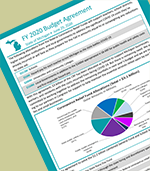Budget deal includes $175 per-pupil spending cut

Gov. Gretchen Whitmer and Republican legislative leaders announced a tentative agreement this week to address the projected $2.2 billion shortfall in this year's state budget. The agreement, which makes use of federal coronavirus-related assistance, applies to the current fiscal year that ends on September 30. Despite $950 million in federal aid earmarked for coronavirus spending, the a further $1.2 billion in spending cuts or transfers from the state reserve are needed, with K-12 school aid slated for a $256 million reduction (about $175 per pupil) in the current year.
In their May revenue estimation conference, top state economists dramatically lowered projected tax revenues because of the slowdown triggered by the COVID-19 pandemic and the lockdown orders it necessitated. Under Michigan's constitution, the state must maintain a balanced budget, and the estimation conference develops the numbers the budget must match.
For the current fiscal year, the economists projected a deficit in the General Fund and the School Aid Fund of nearly $1.1 billion each. The budget for this year must be adjusted to take those reduced revenues into account, which led to Monday's agreement between the governor and House Speaker Lee Chatfield (R-Levering) and Senate Majority Leader Mike Shirkey (R-Clarklake).
Overall, some $950 million in coronavirus relief funds (from the federal CARES act and other measures) would be used to soften the blow to the budget, though to meet current federal requirements the state must allocate those funds solely to pandemic-related expenses. (For more about federal assistance so far, see the briefing papers from UM's Center for Local, State & Urban Policy here and here.) About $565 million of that will go to K-12 public schools to help offset costs from the shift to offsite teaching and preparations for re-opening in the fall. The figure includes $53 million in "hazard pay" for teachers.
In addition to the $256 million cut to K-12 schools, the agreement includes:
- $200 million in reductions to state universities and community colleges;
- $97 million in reductions to local government revenue sharing;
- $490 million in reduced state government spending, including hiring and spending freezes along with other cuts; and
- a $350 million withdrawal from the state Budget Stabilization Fund. Legislative leaders describe this agreement as a "framework," with many of the details yet to be hammered out.
Yet to be addressed is a projected $3 billion shortfall in the combined budget for next year (FY 2021), which begins on October 1. In contrast to some earlier disagreement, state leaders from both parties now call for federal assistance to states to prevent even sharper cuts to public services such as education in the coming year. (Sen. Shirkey, however, issued a separate statement urging Congress to err on the side of spending restraint.) Congress is weighing several different bills that would provide budget support for states to cover revenue losses stemming from the pandemic, but the US Senate will not begin to look at those bills until it returns in mid-July.
